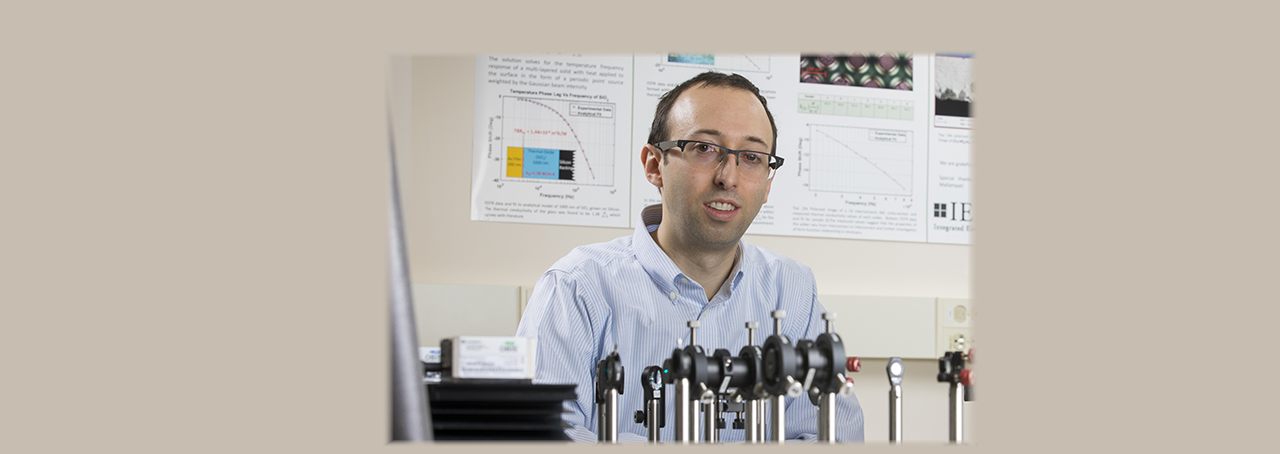TAF Impact: New Standards for a Nascent Industry
Still in its infancy, metal 3D printing is part 21st century, part Dark Ages. It can produce a biomedical implant so porous that it integrates into a patient’s bones, yet the metal in the implant is appraised with a sand clock, a device invented in the 8th century to measure time.
Now, Dr. Scott Schiffres, associate professor of mechanical engineering at Binghamton University, has invented a technology that harnesses the laser on a metal 3D printer to accurately assess the age, quality, and extent of oxidation of the metal powder. His innovation received an investment from the SUNY Technology Accelerator Fund in 2022. When commercialized, the testing technology can save hundreds of millions of dollars, reduce materials waste, lower energy use, and help set desperately needed standards for the industry.
Metal 3D printing, also known as additive manufacturing, works by adding metal just where it’s needed, versus conventional manufacturing, which cuts metal away from a preexisting shape. That allows metal 3D printing to create unique, lightweight, and complex parts that conventional manufacturing can’t. Schiffres focuses on laser powder bed fusion, in which a thin layer of metal powder is deposited, and a high-powered laser melts the powder where the part will be. The process is repeated layer by layer. When the part is complete, it’s encased in unmelted metal powder, like a plastic bucket buried beneath a sand castle.
That unmelted powder is very, very expensive, but it can be reused. Says Schiffres, “The metal sand near the part is very valuable, so companies want to save it and reuse it. But the question is, How many times can you reuse the powder before it's no longer going to give you a high-quality part? Should NASA require only new powder to be used every time, or can they allow the powder to be used up to three times? Ten times? The standards are well known for conventional manufacturing, but not for metal 3D printing.”
Some companies get their powder tested at an outside lab, but that takes time and money. Meanwhile, current methods for evaluating powder on site are archaic and imprecise. One method uses a strip of coated paper to record moisture content. The other method—the infamous 8th-century sand clock—deposits powder into a funnel, then times its descent; if it flows slowly or badly, the powder is judged to be unfit for use. Says Schiffres, “That tells you something about whether the powder recoats well, but not much else. Our technology uses the laser that's already in the printer to see on an atomic level how much the powder is degraded. It can even tell a customer how to tune the printing process to a specific powder.”
Schiffres first got into metal 3D printing as a postdoc at MIT, but his inspiration for the materials testing technology came to him at his Binghamton lab, home to the Nano-Micro Thermal Group. The team noticed that the thermal properties of 3D printed aluminum and steel changed with processing, making Schiffres wonder whether their thermal properties revealed something about their microstructure. Schiffres’s other area of research is thermal property measurement, and he realized that he could adapt the laser on the printer to measure thermal properties of metals.
Working on the TAF application helped him further refine the idea. “The TAF folks pushed us to identify the minimum viable product we could actually make and implement. That made me realize my laser idea was too big. However, there's also a need for understanding the powders better, because there are no clear standards for how many times they can be reused. I thought it could be very useful for industry if I made a tool to address that,” says Schiffres.
After winning the TAF investment, Schiffres received funding from the National Institute of Standards and Technology to expand his research on the properties of metal powders. He’s collaborating with Guangwen Zhou, professor of the Department of Engineering and Associate Director of the Institute of Materials Research, and Srikanth Rangarajan, research professor in the Department of Mechanical Engineering. Zhou analyzes the effect of oxygen atoms on metal surfaces using transmission electron microscopy; Rangarajan uses AI to convert the oxidation signals into information a 3D printer can use to match the printing process to a specific powder.
The NIST award frees Schiffres to pivot his TAF funds toward customer discovery. “We’re thinking about how to market this for different types of printers,” he says. “Some customers could use a plugin. Others may need additional hardware, some only software. We have a test we're using right now, but we want to improve it to bring to potential licensees and demonstrate it on site.”
Schiffres can already see how the NIST-funded research with Zhou and Rangarajan will make his materials testing technology appeal to an even broader range of customers: the collaboration will enable them to play with such variables as powder size, oxide thickness, or even which metal to use. Says Schiffres, “I believe we'll get additional IP from these efforts, and we can leverage them on the TAF award.”
comments powered by Disqus


